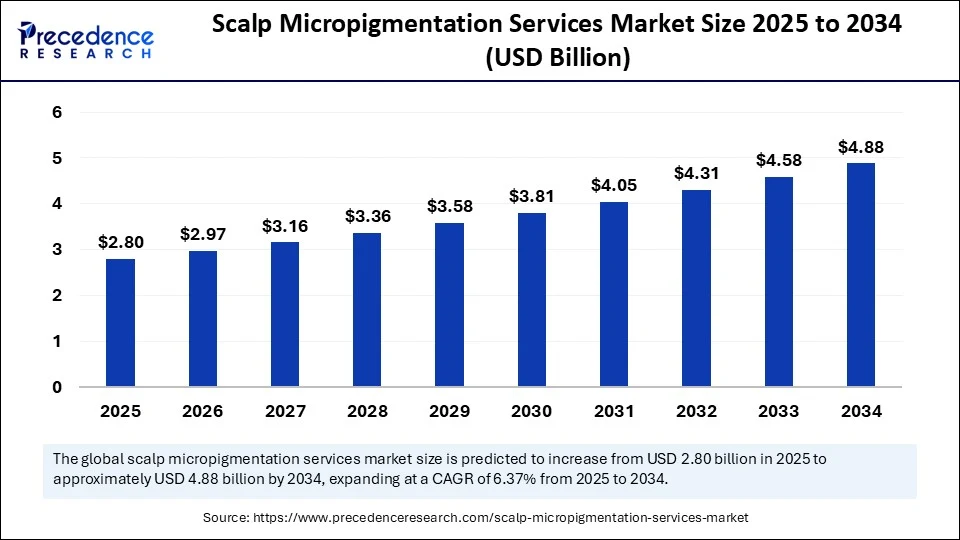Scalp Micropigmentation Services Market Size to Reach USD 4.88 Billion by 2034, Driven by Growing Demand for Non-Surgical Hair Restoration
Scalp Micropigmentation Services Market Size And Forecast 2025 to 2034
The global scalp micropigmentation (SMP) services market is set for significant growth, projected to expand from USD 2.80 billion in 2025 to USD 4.88 billion by 2034, at a robust compound annual growth rate (CAGR) of 6.37%. This surge is fueled by increasing demand for minimally invasive, non-surgical hair loss solutions, rising consumer awareness, and advancing technological innovations within the aesthetic treatments domain.

Scalp Micropigmentation Services Market Key Insights Define the Scalp Micropigmentation Market Today
The market’s rapid expansion is highlighted by several crucial statistics: In 2024, the global SMP market was valued at USD 2.63 billion.
North America leading in revenue generation. The Asia Pacific region is the fastest-growing market, benefiting from rising healthcare infrastructure and medical tourism. The U.S. market alone is expected to reach USD 1.32 billion by 2034.
Among service providers, dedicated SMP clinics hold the largest market share, whereas freelance artists and studios are the fastest-growing segment. Full-head applications dominate the use cases, although hairline and temple applications are gaining traction due to increased aesthetic awareness. While men remain the primary consumer base, female uptake is accelerating with tailored treatment protocols.
Scalp Micropigmentation Services Market Revenue: Global and U.S. Market Revenues in USD Billion
| Year | Global Market Size | U.S. Market Size |
|---|---|---|
| 2024 | 2.63 | 0.70 |
| 2025 | 2.80 | 0.75 |
| 2034 | 4.88 | 1.32 |
AI is revolutionizing the SMP market by enhancing patient consultations with advanced imaging and visualization tools that provide realistic preview outcomes, helping clients make informed decisions. Machine learning algorithms assist practitioners in precise pigment color matching, improving the natural appearance of SMP treatments. Additionally, AI-powered training modules and remote consultation platforms are increasing global accessibility and consistency across service providers. The integration of AI with robotics is automating parts of the treatment process, accelerating service delivery while maintaining quality and safety standards.
Get this report to explore global market size, share, CAGR, and trends, featuring detailed segmental analysis and an insightful competitive landscape overview @ https://www.precedenceresearch.com/sample/6660
Which Factors Are Driving the Growth of SMP Services?
The primary forces fueling market growth include a rising preference for non-invasive aesthetic solutions, shifting social attitudes toward hair loss, and demand for fast, confidence-enhancing results. SMP offers a cost-effective, low-maintenance alternative to surgical hair restoration. Furthermore, expanding awareness through social media and endorsements by celebrities boosts consumer confidence and acceptance globally.
What New Trends and Opportunities Are Emerging in the SMP Industry?
Is the market evolving beyond traditional demographics? Yes there is growing adoption among women and younger adults, enticing new market segments. Increasing social media influence and the rise of medical tourism in regions like Asia Pacific unlock fresh opportunities. Innovations in pigment technology and device design enable premium, customized SMP services, expanding the market potential for providers.
What Are Industry Experts Saying About These Developments?
“With AI-driven precision in scalp micropigmentation, we are witnessing a transformation of hair restoration standards worldwide. Our clients gain not just aesthetic improvements but renewed self-confidence through safe and natural solutions. The next frontier involves even greater personalization and broader global access,” remarks Lila Desai, Principal Consultant at Precedence Research.
How Do Regional and Market Segments Shape the SMP Landscape?
Regionally, North America remains the leader due to widespread consumer awareness, access to premium clinics, and cultural acceptance. The Asia Pacific region is the fastest-growing market, supported by high hair loss prevalence, developing healthcare sectors, and booming medical tourism hubs like India, China, and South Korea. Europe, Latin America, and the Middle East and Africa also exhibit growth driven by urbanization and increasing interest in cosmetic solutions.
Segment-wise, male pattern baldness dominates treatment categories; however, therapies for alopecia are rapidly gaining momentum. Dedicated SMP clinics contribute the bulk of market revenue, while freelance professionals and micro-entrepreneurs are fast expanding. Men constitute the largest customer base, but female participation is rising with gender-specific SMP treatments. Application-wise, full-head coverage commands the highest market share, but treatment for hairlines and temples is growing fastest among younger users.
Which Company Innovations and Breakthroughs Are Influencing Market Dynamics?
Recent advancements include Bernstine Medical’s specialized scalp micropigmentation program designed to conceal FUT (Follicular Unit Transplant) scars painlessly and non-surgically. Several top players utilize state-of-the-art pigment technologies and imaging equipment to enhance client outcomes. The landscape features both established clinics and freelance practitioners who personalize SMP services to meet growing consumer demand.
Scalp Micropigmentation Services Market Key companies
- Bernstine Medical
-
Schweiger Dermatology Group
What Challenges and Cost Pressures Are Constraining Growth?
Despite its upward trajectory, the SMP market faces challenges such as limited public awareness in certain regions, lack of standardized regulatory frameworks, and inconsistent service provider quality. Poor outcomes from undertrained or unqualified practitioners can lead to emotional distress and increased costs due to corrective procedures such as laser removal, additional SMP sessions, or hair transplants.
Are There Illustrative Cases Highlighting Industry Challenges?
A retrospective study revealed that 90% of corrective SMP treatments originated from work by non-specialist providers. Effective correction involved a combination of laser removal, refined SMP reapplications, and in some cases, surgical interventions, underscoring the critical need for rigorous training, certification, and quality assurance in the SMP industry.
Read Also: Hyaluronic Acid Personal Care Products Market
You can place an order or ask any questions, please feel free to contact us at sales@precedenceresearch.com |+1 804 441 9344
